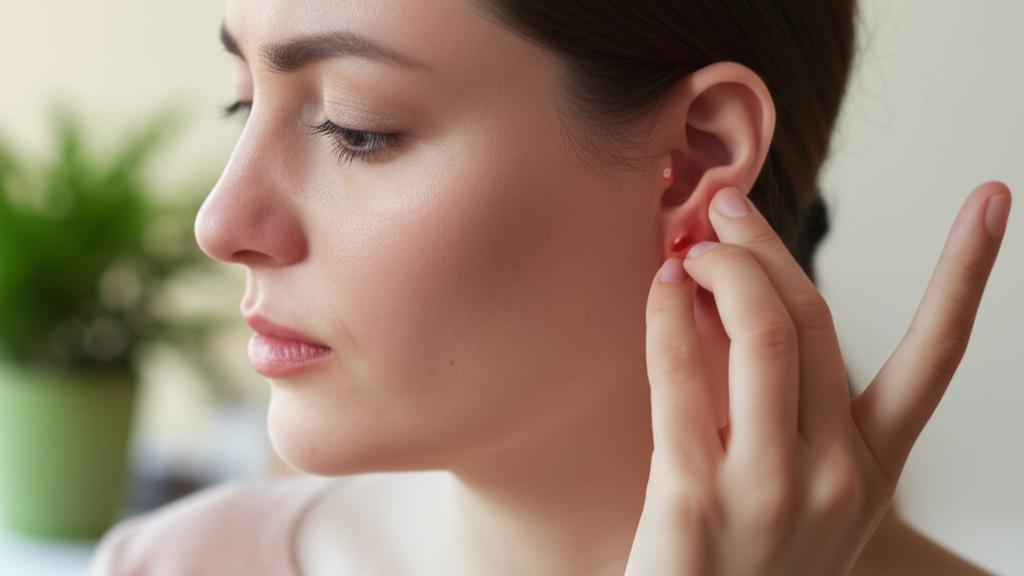Picture this: you’re settled in for the evening, maybe reading a book or catching up on a show. Suddenly, that familiar, nagging itch starts. Deep inside your ear, or maybe on the delicate skin of your earlobe. It’s distracting, isn’t it? You try to ignore it, but it just. keeps. coming. back. Sometimes it’s dry and flaky, other times it’s red and angry. If this sounds like you, you’re not alone, and we might be talking about something called ear eczema.
So, what exactly is ear eczema? Think of it as a specific type of skin inflammation, also known medically as atopic dermatitis, that decides to show up in or around your ears. Normally, your skin has this amazing barrier, like a well-built brick wall, keeping moisture in and irritants out. With eczema, that wall gets a bit compromised. It becomes less effective, making your skin super sensitive, prone to drying out, and unfortunately, more susceptible to little infections.
Now, you might wonder if it’s like psoriasis. They can seem similar, but they’re different beasts. Psoriasis often shows up as thicker, silvery patches and can be less intensely itchy than eczema. And while anyone can get ear eczema, I do see it a bit more in folks who have a history of eczema elsewhere, or maybe asthma or even hay fever. It’s pretty common, actually – a fair number of children and even adults deal with it.
What Does Ear Eczema Feel and Look Like?
When ear eczema is making itself known, it’s not just a fleeting bother. You might experience:
- That persistent, sometimes intense itch. It can be on the outer ear, just inside the canal, or even in that little crease behind your ear.
- Skin that feels incredibly dry, maybe even a bit like sandpaper.
- Redness or a change in skin color where it’s irritated.
- Little bumps that pop up.
- Patches of skin that feel leathery or thickened over time.
- Sometimes, the skin can get crusty.
- A bit of swelling in the affected area.
The good news? Ear eczema itself usually isn’t painful. But, and this is a big ‘but,’ if you scratch (and oh, it’s tempting!), you can break the skin. That opens the door for an infection, and that can definitely bring on pain. In some really bothersome cases, especially if it’s deep in the ear canal, you might even notice some ringing in your ears (we call that tinnitus) or a slight change in your hearing.
Why Me? Understanding Ear Eczema Triggers
It’s natural to ask, “Why is my ear doing this?” Well, ear eczema can pop up for a few reasons, and sometimes it’s a mix. Here are the common culprits I see:
- Allergic Eczema (Contact Dermatitis): This is when your immune system gets a little overenthusiastic about something it touches. Think nickel in earrings – a very common one! But it could also be fragrances in hair products, certain soaps, pollen that settles on your ear, or even your cell phone or headphones if they have materials that irritate your skin.
- Asteatotic Eczema: This one often visits folks as they get a bit older, say 65 and up. It loves dry air, so winter can be a prime time for flare-ups. Harsh soaps don’t help either.
- Seborrheic Dermatitis: This type likes the oilier parts of your body, and yes, your ears can be one of them (along with your scalp – think dandruff – nose, and chest). We’re not 100% sure on the exact cause, but an overgrowth of a normal skin yeast seems to play a role. Weird, right?
And just to put your mind at ease, ear eczema isn’t something you can catch from someone else. It’s not contagious.
Getting to the Bottom of It: Diagnosing Ear Eczema
When you come in worried about your ears, the first thing I’ll do is have a good look. I’ll check the skin on and around your ears for those tell-tale signs like redness, dryness, or any changes in texture. I’ll likely use a little lighted tool called an otoscope to peek inside your ear canal – it helps me see what’s going on in there. And, of course, I’ll ask you all about your symptoms: when they started, what makes them worse, what you’ve tried.
Most of the time, we can get a pretty clear idea just from this. But if things are a bit murky, or if we need to rule out other possibilities, we might consider:
- An allergy skin test, especially if we suspect contact dermatitis. This helps us pinpoint specific triggers.
- Simple blood tests to check for other things that could cause a rash.
- Rarely, a skin biopsy. This means taking a tiny sample of skin to look at under a microscope. A specialist called a pathologist (a doctor who studies tissues and cells that have been removed from the body) examines it to help us distinguish between different types of skin conditions.
Finding Relief: Your Treatment Plan for Ear Eczema
Okay, so we know it’s ear eczema. Now, how do we calm it down? Our main goals are to soothe that itch, reduce the discomfort, prevent any infections, and try to keep future flare-ups at bay.
A lot of it starts with what you can do at home. It’s really about identifying what sets off your ear eczema and trying your best to avoid those triggers. Here’s what often helps:
- Identify and Avoid Allergens: If you’ve figured out that nickel earrings are the problem, it’s time to switch to hypoallergenic ones. Same goes for irritating soaps or hair products.
- Humidify Your Air: If dry air is a trigger (especially in winter), a humidifier in your bedroom can make a big difference.
- Protect in the Cold: A soft, warm hat that covers your ears is your friend in chilly weather.
- Hands Off! I know it’s hard, but try, try, try not to scratch or rub. This just makes it angrier.
- Gentle Creams: An over-the-counter hydrocortisone cream (usually 1%) can be a good first step for mild itch and redness. Use it sparingly for a short time as directed.
- Moisturize, Moisturize, Moisturize! This is key. Use a thick, plain, fragrance-free ointment or cream. Lotions are often too thin. Apply it several times a day, especially right after a lukewarm shower or bath to trap that moisture. Think of it as rebuilding that skin barrier.
- Bathing Smarts: Keep showers or baths lukewarm, not hot. Hot water strips oils from your skin. And keep them on the shorter side, under 15 minutes. Gently pat your ears dry.
- Mild Products Only: Choose soaps, shampoos, and conditioners that are free of perfumes, dyes, and alcohol. Look for labels like “fragrance-free,” “hypoallergenic,” or “for sensitive skin.” Same goes for your laundry detergent.
- Ceramides Can Help: Some products contain ceramides, which are like the natural “glue” in your skin barrier. These can be really helpful.
- Cotton is King: Stick to soft, breathable cotton clothing if your eczema is also on skin that touches your clothes. Wool and some synthetic fabrics can be irritating.
- Antihistamines for Itch: If the itching is really driving you nuts, an over-the-counter antihistamine might offer some relief, especially at night.
Sometimes, home care isn’t quite enough, and that’s okay. That’s when we might talk about:
- Prescription Steroids: These can be stronger creams, ointments, pills, or even ear drops. They’re very effective, but we use them carefully due to potential side effects with long-term use, like skin thinning.
- Topical Immunomodulators (TIMs): These are newer prescription creams or ointments that work by calming down the immune response in the skin. They’re a good option if steroids aren’t suitable or haven’t worked well, and they tend to have fewer side effects.
- Phototherapy: This involves controlled exposure to specific types of ultraviolet (UV) light. It sounds a bit space-age, but it can be quite effective for stubborn eczema.
What about good old petroleum jelly (like Vaseline™) or other skin care ointments (like Aquaphor™)? Yes, they can be helpful! They’re great at creating a protective barrier and locking in moisture, and they’re generally hypoallergenic. Some also have properties that can help the skin heal. Just gently cleanse your ear and apply a thin layer with a cotton swab.
With the right approach, you should start feeling better within one to three weeks. But it’s important to remember that ear eczema can be a bit of a long-term companion. There’s no magic cure that makes it vanish forever, but we can get very good at managing it and keeping those flare-ups to a minimum.
Key Things to Remember About Ear Eczema
Alright, that was a lot of information! If you’re dealing with itchy, unhappy ears, here are the main things I want you to take away:
- Ear eczema is a common skin condition causing dryness, itchiness, and redness in or around your ears.
- It’s not contagious, so you don’t have to worry about spreading it.
- Identifying and avoiding your personal triggers (like certain metals, fragrances, or dry air) is a huge step.
- Gentle skincare is your best friend: mild cleansers, lukewarm water, and lots of fragrance-free moisturizer.
- Don’t scratch! It can lead to infection and make things worse.
- There are effective treatments, from home remedies and over-the-counter creams to prescription options if needed.
- While ear eczema can be chronic, we can work together to manage it and keep you comfortable.
Dealing with any kind of eczema can be frustrating, especially when it’s in a sensitive spot like your ears. But please know you’re not on your own with this. We have lots of ways to help you find relief and get back to feeling more comfortable in your own skin. Don’t hesitate to reach out.


